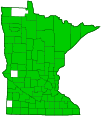Canadian woodnettle
(Laportea canadensis)
Conservation • Wetland • Description • Habitat • Ecology • Use • Distribution • Taxonomy
Description |
||
Canadian woodnettle is a 16″ to 40″ tall, erect, annual or perennial forb that rises from a rhizome and tuberous roots. It often forms dense colonies. The stems are erect, light green or medium green, zigzagged, and unbranched. They are sparsely or densely covered with stinging hairs and non-glandular, non-stinging hairs, but they have no glandular hairs. The leaves are alternate, broadly egg-shaped, 3″ to 6″ long, and 1″ to 4″ wide. They are on leaf stalks that are up to 4″ long and covered with stinging and non-stinging hairs. They taper to a point at the tip with concave sides along the tip. They are rounded, squared off, or broadly wedge-shaped at the base, but do not have ear-like lobes at the base. The margins have sharp, forward-pointing teeth. The upper surface is medium to dark green, the lower surface is a little lighter in color. Young leaves appear wrinkled and are densely covered with both stinging and non-stinging hairs. As they age they become less wrinkled and less hairy. Both male and female flowers are found on the same plant. The female inflorescences are elongated, loose, branched clusters at the end of the stem and rising from the upper leaf axils. They are widely spreading and up to 4″ long, usually much longer than the subtending leaf stalks. The male inflorescences are elongated, branched clusters rising from the middle leaf axils. They spread outward from the stem and are seldom longer than the subtending leaf stalks. The male flowers are 1 ⁄32″ to 1 ⁄16″ across, with 5 narrow, greenish-white to white sepals, no petals, and 5 stamens. The female flowers are 1 ⁄32″ to 1 ⁄16″ across, with 2 large, green, appressed, inner sepals, 2 much smaller, green, appressed, outer sepals, no petals, and a long, feathery, D-shaped style. The fruit is an egg-shaped achene, 1 ⁄16″ to 3 ⁄32″ in diameter. |
||
Height |
||
16″ to 40″ |
||
Flower Color |
||
Green |
||
Similar Species |
||
Stinging nettle (Urtica dioica ssp. gracilis) leaves are opposite, narrower, and drooping. Small-spike false nettle (Boehmeria cylindrica) has no stinging hairs. The leaves are opposite. |
||
Habitat |
||
Moderate moisture. Woods, forests. |
||
Ecology |
||
Flowering |
||
July to August |
||
Pests and Diseases |
||
|
||
Use |
||
|
||
Distribution |
||||
|
Sources |
|||
| 3/22/2023 | ||||
Nativity |
||||
Native |
||||
Occurrence |
||||
Common |
||||
Taxonomy |
|||
| Kingdom | Plantae (Plants) | ||
| Division | Tracheophyta (Vascular Plants) | ||
| Subdivision | Spermatophytina (Seed Plants) | ||
| Class | Magnoliopsida (Dicots) | ||
Order |
Rosales (Roses, Elms, Figs, and Allies) | ||
Family |
Urticaceae (nettle) | ||
Genus |
Laportea (wood nettles) | ||
Subordinate Taxa |
|||
|
|||
Synonyms |
|||
Fleurya canadensis Laportea divaricata Laportea pustulata Urtica canadensis Urtica divaricata Urtica pustulata Urticastrum divaricatum |
|||
Common Names |
|||
Canada lettuce Canada woodnettle Canadian wood-nettle Canadian woodnettle wood nettle wood-nettle |
|||
Glossary
Achene
A dry, one-chambered, single-seeded seed capsule, formed from a single carpel, with the seed attached to the membranous outer layer (wall) only by the seed stalk; the wall, formed entirely from the wall of the superior ovary, does not split open at maturity, but relies on decay or predation to release the contents.
Axil
The upper angle where the leaf stalk meets the stem.
Glandular hairs
Hairs spread over aerial vegetation that secrete essential oils. The oils act to protect against herbivores and pathogens or, when on a flower part, attract pollinators. The hairs have a sticky or oily feel.
Rhizome
A horizontal, usually underground stem. It serves as a reproductive structure, producing roots below and shoots above at the nodes.
Sepal
An outer floral leaf, usually green but sometimes colored, at the base of a flower.
Visitor Photos |
|||||
Share your photo of this plant. |
|||||
| This button not working for you? Simply email us at info@MinnesotaSeasons.com. Attach one or more photos and, if you like, a caption. |
|||||
|
|||||
MinnesotaSeasons.com Photos |
|||||
Habitat |
|||||
 |
|||||
Colony |
|||||
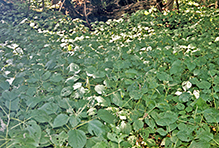 |
|||||
Plant |
|||||
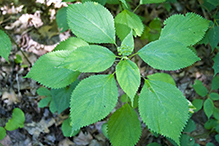 |
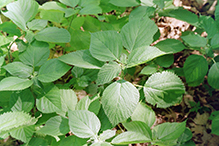 |
||||
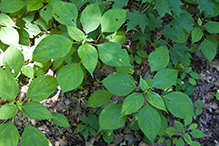 |
 |
||||
Inflorescence |
|||||
 |
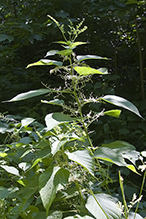 |
||||
Male Flowers |
|||||
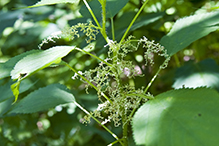 |
|||||
Female Flowers |
|||||
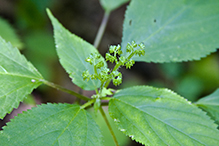 |
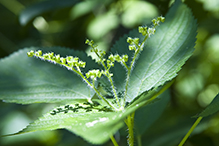 |
||||
 |
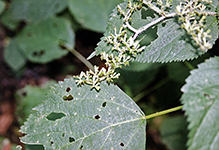 |
||||
Leaves |
|||||
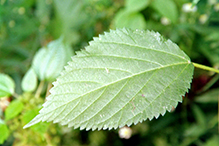 |
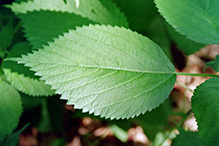 |
||||
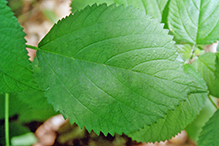 |
|||||
Stem |
|||||
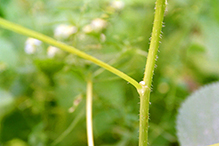 |
|||||

Slideshows |
||

Visitor Videos |
|||
Share your video of this plant. |
|||
| This button not working for you? Simply email us at info@MinnesotaSeasons.com. Attach a video, a YouTube link, or a cloud storage link. |
|||
Other Videos |
|||
| Wild Edibles series- Wood Nettle 1.wmv White Wolf Von Atzingen |
|||
About
Uploaded on Jun 11, 2010 More in my wild edibles series. I was asked by many about the wood nettle and so decided to make a short edibility clip on it. Enjoy! Use caution when trying new foods. Some people are allergic. Be aware, these videos are for informational purposes only. Ways Of The Wild Institute claims no responsibility for the misuse of this information. |
|||

Visitor Sightings |
|||||
Report a sighting of this plant. |
|||||
| This button not working for you? Simply email us at info@MinnesotaSeasons.com. Be sure to include a location. |
|||||
|
|||||
MinnesotaSeasons.com Sightings |
|||||
Carpenter St. Croix Valley Nature Center Charles A. Lindbergh State Park Clifton E. French Regional Park Forestville/Mystery Cave State Park Hardscrabble Woods / MG Tusler Sanctuary John Peter Hoffman Spring Brook Valley WMA Mary Schmidt Crawford Woods SNA Minnesota Valley NWR, Chaska Unit Minnesota Valley NWR, Louisville Swamp Unit Minnesota Valley NWR, Wilkie Unit Minnesota Valley State Recreation Area, Lawrence Unit Nerstrand Big Woods State Park P.N. and G.M. Nelson Wildlife Sanctuary Robert Ney Memorial Park Reserve |
|||||

|
Created: Last Updated: © MinnesotaSeasons.com. All rights reserved. |
